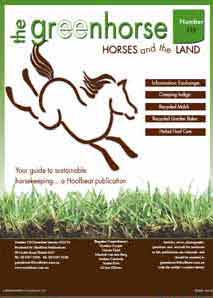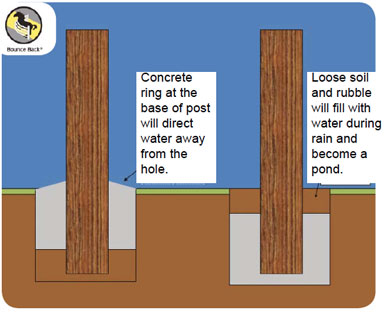The Green Horse section provides practical information on managing environmentally sustainable horse properties, readers stories and tips, as well as advice and articles from equestrian experts in their fields.
April/May 24
Vol 45 No6
In this issue of The Green Horse you will find the following articles
ARENA DEVELOPMENT AND MAINTENANCE
by Liz Tollarzo
A very expensive addition to any
property, a riding arena takes up lots of time, planning, preparation and money to establish and as such it is important to keep the arena in the best condition to protect this investment and also to protect our
equine partners.
HERBS FOR AUTUMN
by Catherine Bird- for Country Park Herbs
Take a holistic approach to your equine's health care. This Autumn blend helps prepare your horse for the colder months of winter and focusses on promoting balance and harmany within the body.
WIN A YEAR'S SUBSCRIPTION...
share your equine property management tips and each issue one reader will win.
Send ideas to -
The Green Horse Support <enquiries@hoofbeats.com.au>


PREVIOUS ARTICLES
Available on line
February March 24
CAN A SOIL TEST TELL YOU WHAT IS IN YOUR PASTURE?
by Nerida Richards - Feed XL
A definite recommendation for horse owners is to have their pasture and hay tested so they get a much more accurate idea of what their horses are eating.
August September 23
CREATING AND USING THE SACRIFICE PADDOCK
Functional areas that are safe and useable are essential, with an area set aside as a ‘sacrificial’ area or paddock considered by many horse owners to be an invaluable component of their property’s set up and design.
June July 23
CREATING A WEED MANAGEMENT PLAN - your property your weeds.
by Rhiannon Brown, Envirapest
Keep it Simple as making a weed management plan doesn’t have to be like studying for that master’s degree or passing your driving test for the first time either.
Apriil/May 23
SIMPLE FEED BUDGET
by Belinda Taylor
Although most horse owners are nervous at the prospect of creating a budget, a few quick
calculations can give you the power to compare prices and alternatives that can reduce your horses’ feed
costs, without impacting on their health and wellbeing.
February/March 23
CROFTON WEED KILLS HORSES
by Angela Davison
If you have this weed on your property then it is best to not have any horses in the paddock until such time as you can eradicate it.
December/January 22 23 PROPERTY PLANNING
-Working with your property- not against it.
by Teele Worrell
Property planning is about
using your property effectively
and efficiently and sometimes
starting with a clean slate.
October/November 22
WHAT IS EQUESTRIAN LANDCARE
by Teele Worrell
Part 1 In a series in which Teele will explore what equine landcare is, and why it benefits equine landholders
August/September 22
THE IMPORTANCE OF GROUND COVER
by Belinda Taylor
Ground cover, whether it be dead grass, weeds, hay, or mulch is the insulating layer that protects your soil from the extremes of temperature and erosion.
June/July 22
SOLAR FOR YOUR ARENA
Environmentally-friendly solar lighting for your arena will allow you to use your arena for longer, and as energy from the sun is free it is therefore an ideal long-term solution for powering lights. Jeff Florence from Blackfrog Solar, Queensland suggsted some solar tips.
April/May 22
MAKING THE MOST OF MOSQUITO CONTROL
by Rhiannon Brown - Envirapest
Climate change that has brought high temperatures, more rain and increases in humidity will provide ideal breeding grounds for the many species of mosquitoes, including those that spread the Japanese Encephalitis virus (JEV).February/March 2022
February/March 22
SUSTAINABLE DEWORMING
by Sophie Fletcher
There has been a relatively big shift in deworming treatment strategies in recent years, due to increasing levels of worm resistance to the chemicals we have been using for decades to control them, resulting in a lot of confusion among horse owners.
December/January 21/22
ARE YOU PREPARED FOR THE FIRE SEASON
In the many areas where horse owners live this season's fire preparation should be well underway; if you’ve not already started preparing your property for summer then now is the time to do so.
October/November21
SNAKE UNIVERSAL ANTIVENOM
The good news is that there is no longer any need for a snake to be identified to administer antivenom. A universal antivenom is now used that covers the five genus of snake that will cause serious harm or death.
August/September 21
BEAT THE BINDI
by Rhiannon Brown - Envirapest
The prickly weeds that grow on our properties across Australia usually have long classical Latin names, are often known by a variety of common names in different localities but are regularly called very rude names when we happen to stand on one (or a dozen) or when they find our hands as we are dislodging tangles in the horse’s mane or tail.
June July 21
BARN OWLS by Wendy Elks
A silent partner in rodent control.
Non-toxic pest management is the most humane and ecologically sustainable way of bringing nature back into some kind of balance during non-plague times.
April/May 21
LOVELY LAWNS
by Rhiannon Brown - Envirapest
On a horse property there always seems to be hectares of grass, but we all have that little bit of lawn we want to look luscious all year round.
It could be the entrance to the stables, laneways bordering the driveway, that little ‘special’ snack paddock or you could even dream of a beautiful green arena. So, how do we achieve this?
Feb/March 21
STABLE DANGERS
by Elizabeth Tollarzo
They say that horses are accidents-waiting-to-happen as they are inclined to find every conceivable way to injur themselves, usually just before a competition. Being aware of potential dangers in the stable - and addressing these - may help aleiviate injury.
Dec/Jan 20/21
HORSES AND HONEY BEES-
Can they share space on the property?
by Wendy Elks
Oct/Nov 20
SOLAR-POWERED PRODUCTS
by Celine Bønnelykke
In previous issues we have discussed the economics of setting up a solar-driven property, but if finances don’t stretch to installation of the whole package, there are ways to ease into the solar-world.
Aug/Sept 20 THE HIDDEN DANGERS IN OUR PADDOCK.
by Elizabeth Tollarzo
Horses love to run, play, buck and then run again and we often, through lack of risk assessment or management practices, place them in areas that are fraught with dangers.
JUNE JULY 20 GOING SOLAR ON THE HORSE PROPERTY Where to put your panels Part 2
Once you have selected what solar system best suits your needs, then you need to look at how you can maximise the advantages.
APRIL MAY 20 GOING SOLAR ON THE HORSE PROPERTY Part 2
Once you have selected what solar system best suits your needs, then you need to look at how you can maximise the advantages.
FEB/MARCH 20 ANTS AWAY
by Mark Brown Envirapest
So, what can you do to deter ants from your house and your stables??
DJ19/20 KEEPING SNAKES OUT OF THE STABLE by Wendy Elks
Snakes may be protected under Wildlife regulations in Australia, and they may be great for keeping the mice and rats down, but do we want to find them in our stables near our horses and pets?
ON19 - TERMITES- common myths
by Rhiannon Brown, Envirapest
Your house and stables are looking wonderful this spring, but do you know what is happening inside the walls of your brick or timber building?
AS19 - OUCH THAT HURTS
by Catherine Bird for Country Park Saddlery
The extent of the swelling is usually an indication of the severity of the infection or injury and the cause needs to be established before giving herbs.
JJ19 - MANAGING PASTURE
by Rhiannon Brown, Envirapest Healthy pasture means healthy horses.
A/M19 - STOP THOSE WEEDS
Property biosecurity
by Rhiannon Brown, Envirapest
Putting simple precautionary steps into place can make it tough for weeds to get a hold on your equine paradise.
|
  
  


 AS SEEN IN THE FEB MARCH 24 ISSUE AS SEEN IN THE FEB MARCH 24 ISSUE
Timber posts tend to rot at the base. It is a normal process in the breakdown of the wood, but it can be postponed, giving a longer life to the fence post.
When post holes are dug with a shovel or auger, the disturbed soil is less compact than the surrounding soil. The hole then can become like a pond. Heavy soils like clay can hold this water for an extended period. Rain will run down the face of the post and the water will settle in the softer soil at the base. (Also ground water will run along compact soil until it finds some soft soil to dam up in at the base of your post). Thereby the timber post is left sitting in a pond of water.
Note if there is concrete in the bottom of that hole this might further prevent the water draining down deeper into the soil.
A simple tip on how to use concrete to direct the water can overcome this problem.
To overcome this issue use a concrete ring at surface level to direct water away from the base of the post and away from the hole. Also note that the very bottom of the hole is filled with compacted soil and rubble.
This will allow any water that does makes its way to the base of the post to drainaway. Obviously moist soil will impact the life of a timber post. This method can only prolong the life by diverting as much water away as possible.
In the drawing, below, the post on the right highlights how a pond
might be formed. The post on the right will suffer from water being held at its base.
Note: The dimensions used here are just to highlight the issue, in
practice the hole dug for a fence post should be kept as small as
possible.

|